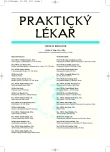Dynamics of oncomarkers duringthe oncological treatment of testicular germinal cell tumours
Authors:
Z. Donátová 1; J. Abrahámová 1; I. Malbohan 2; M. Foldyna 1; J. Nepomucká 1
Authors‘ workplace:
Onkologické oddělení, Fakultní Thomayerova nemocnice, Praha
Přednosta: prof. MUDr. Jitka Abrahámová, DrSc.
; Ústav klinické biochemie a laboratorní diagnostiky, Všeobecná Fakultní nemocnice, Praha
Přednosta: prof. MUDr. Tomáš Zima, DrSc., MBA.
2
Published in:
Prakt. Lék. 2008; 88(1): 50-53
Category:
Case Report
Overview
Testicular germ cell tumours (GCT) are highly curable though require proper management at all stages. GCTs are classified in two major subgroups: seminoma and non-seminoma. Serum concentrations of tumour markers – AFP, LDH and beta-HCG – are an integral part of the TNM classification system as the S category. Independent prognostic factors for progression-free survival for patients with GCT include pre-treatment levels of LDH, HCG and AFP, site of primary tumour (i.e. mediastinal vs. testis or retroperitoneal) and the presence of non-pulmonary visceral metastases (such as bone, brain or liver metastases). We describe representative dynamics of tumour marker levels in 4 patients with advanced GCT. Careful periodic check-ups are required following radiotherapy (for clinical stage I, IIA and IIB seminoma) and after chemotherapy (III stage seminoma, non-seminoma tumours) – which consist of chest X–ray, abdominal CT scan, PET scan, determination of serum concentration of AFP, HCG, LDH and a physical examination. An abnormal marker serum concentration may indicate late relapse.
Key words:
germ cell tumour, seminoma, non-seminoma, tumour marker, TNM classification.
Sources
1. Abrahámová, J., Povýšil, C., Dušek, L. a kol. Nádory varlat. Praha: Grada, 2008 (v tisku).
2. Abrahámová, J. Nádory varlat. Praha: Triton, 2001.
3. Abrahámová, J. Germinální nádory varlat. Referátový výběr® z onkologie, 24, 1/2007, s. 5–26.
4. Bosl, G.J., Bajorin, D.F, Sheinfeld, J. et. al. Cancer of the testis, In: De Vita, V. T., Hellman, S., Rosenberg, S. A. (eds.) Cancer. Principles and practices of oncology. 6th edition, Philadelphia: Lippincott-Raven, 2001, p. 1491–1518.
5. Fleming, I. et. al., eds. AJJC Cancer Staging Handbook. Philadelphia: Lippincott-Raven, 1998.
6. Hermanek, P., Hutter, R.P., Sobin, L.H., Wagber, G., Wittekind, Ch. (eds) TNM atlas, 5th edition, Heidelberg: Springer, 2005.
9. International Germ Cell Cancer Collaboration Group International germ cell consensus classification: A prognostic factor-based staging system for metastatic germ cell cancers. J. Clin. Oncol. 1997, 15, p. 594-603.
10. Klener, P., Abrahámová, J. Nádory mužských pohlavních orgánů. In. Klener, P.: Klinická onkologie, Praha: Galén, 2002.
11. Olenburg, J., Martin, J.M., Fossa, S.D. Late Relapses of Germ Cell Malignancies: Incidence Management, and Prognosis. J. Clin. Oncol. 2006, 24. p. 5503–5511.
12. Sonpavde, T.E., Roth, B.J. Management of Recurrent Testicular Germ cell Tumors. Oncologist 2007, 12 (1), p. 51–61.
Labels
General practitioner for children and adolescents General practitioner for adultsArticle was published in
General Practitioner

2008 Issue 1
Most read in this issue
- Clinical aspects and neurobiology of vascular dementia
- Causal treatment options for lower extremity varices
- Dynamics of oncomarkers duringthe oncological treatment of testicular germinal cell tumours
- Influence of smoking and free radicals on antioxidant defence and on the pathogenesis of certain diseases
